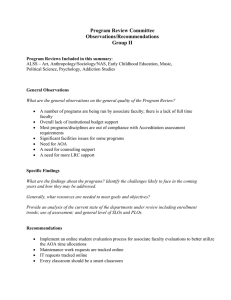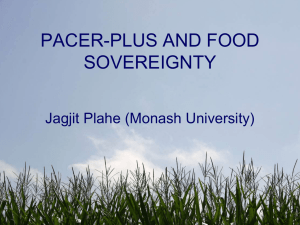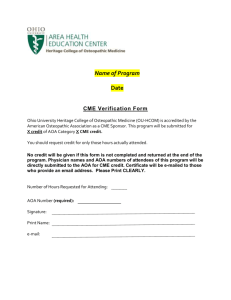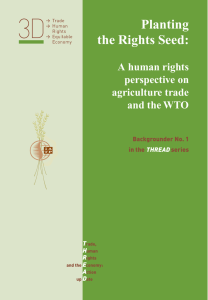WTO Chair Programme
advertisement
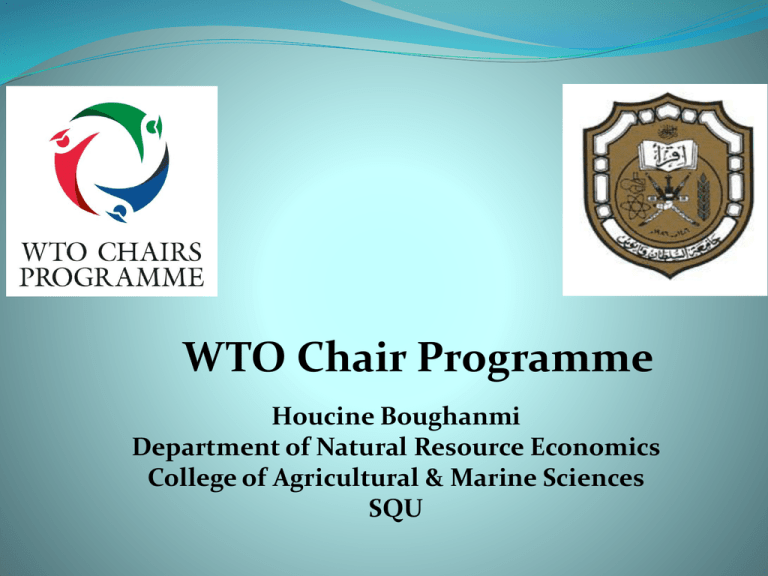
WTO Chair Programme Houcine Boughanmi Department of Natural Resource Economics College of Agricultural & Marine Sciences SQU The WTO Chairs Programme is a partnership between WTO (ITTC) and selected academic institutions in countries members of WTO- New 2014 Pioneers 2010 OBJECTIVES OF THE WTO CHAIR PROGRAMMES Enhance knowledge and better understanding of WTO trading system (multi-lateral trading) among students, academicians, and policy makers through curriculum development, research, and outreach activities RESEARCH FOCUS ADRESSING FOOD SECURITY IN THE MENA REGION THROUGH WTO MULTI-LATERAL TRADING SYSTEM AND MARKET ORIENTED FOOD POLICIES MENA Countries should pursue a threepillar approach Strategy to food security Wheat (Million Tons) 100 1. 1. Adress AddressDemand demand 80 Total Wheat demand 60 exposure Mange 3. 3. Managing exposure to import risks to global price 50 40 Total Wheat Supply 30 productivity Increase Agricultural 2.2.Increase agricultural productivity 20 10 2010 2015 2020 2030 2040 2050 Source:Michelle Battat and Julian Lampietti ( Adapted from IFPRI 2010). Note: Data are based on a model that generates illustrative projections for Arab countries in the Middle East and North Africa region. Data from the “Baseline Perfect Mitigation” scenario were used. Food Security: is there a role for WTO? Agreement on Agriculture (AOA)- 1994 The Three “Pillars” Market access “to establish a fair and a market-oriented agricultural trading system” Export competition Domestic support IS WTO defending an outdated vision of food security? “….WTO agenda has failed to adapt, and developing countries are rightly concerned that their hands will be tied by trade rules Olivier De SchutterUN Special Rapporteur on the right to food 2008-2014 … WTO rules leave little policy space for developing countries to put measures in place to enhance local production “Supporting local food production is the first building block … and trade must complement local production, not justify its abandonment” Do AoA rules fits todays trade environment? Market environment of AOA URAoA Negotiations Start of DDA Collapse of Doha talks Almost all rules and provisions in URAOA aim at regulating/ limiting the policies which have a depressing effect on international prices Food Security Policy Space in the AOA Policy space refers to the autonomy available to countries to implement policies or commit budget expenditures which are not limited or constrained by AoA rules Policy space for import protection Average tariff structure by group of countries, 2013 80 70 60 50 Average bound tariffs (%) 40 Average applied tariffs(%) 30 20 10 0 LDCs Developing countries Developed countries Arab Countries Policy space and domestic support Green Box Policies (AoA: Annex 2) • Have no, or at most minimal, trade-distorting effects or effects on production • All countries • Unlimited De Minimus Rule (AoA: Article 6.4) • 10 % of the value of total agricultural production for non specific measures (LDC) • 10% of the value of the basic agricultural product for specific measures (LDC) Development Box (AoA: developing) (Art.6.2) • Measures to encourage agricultural and rural development (investment subsidies, input subsidies) which are an integral part of the development programmes are exempt of any reduction WTO Rules Applying to Public Food Reserves (Par3 annex 2 AOA) Expenditures in relation to the accumulation and holding of stocks of products for food security purposes Conditions • Purchases made at current market prices • Sales at no less than the current domestic market price • For developing countries purchase price can be made at administered price, but But • The gap between the purchasing administered price and the reference world price should be considered s trade distorting support which is limited (de minimis ceiling). The deadlock is about to make that support green (without limit)

